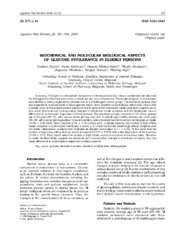| dc.creator | Đurica, Snežana N. | |
| dc.creator | Korićanac, Goran | |
| dc.creator | Ribarac-Stepić, Nevena B. | |
| dc.creator | Davidović, Mladen M. | |
| dc.creator | Milošević, Dragoslav P. | |
| dc.creator | Petrović, Miroljub | |
| dc.creator | Rajić, Miodrag | |
| dc.date.accessioned | 2018-10-01T11:30:04Z | |
| dc.date.available | 2018-10-01T11:30:04Z | |
| dc.date.issued | 2004 | |
| dc.identifier.issn | 0354-3447 | |
| dc.identifier.uri | http://www.doiserbia.nb.rs/Article.aspx?ID=0354-34470402161D | |
| dc.identifier.uri | https://vinar.vin.bg.ac.rs/handle/123456789/7824 | |
| dc.description.abstract | Changes in carbohydrate metabolism in elderly persons have drawn considerable attention but the findings from different studies are in contrast and are even controversial. The insulin receptors in erythrocytes were studied in elderly euglycaemic patients and in a middle-aged control group. The examined persons were also subjected to measurements of blood glucose, insulin and C-peptide concentrations, before and 3 hours after a dietetic meal. In the present study it was found that in spite of the maintained insulin level and C-peptide secretion, some structural and corresponding changes in membrane insulin receptors and the binding site caused differences in postreceptor responses in elderly persons. The examined groups, consisted of 29 males, average age of 66 years (65-70), with normal serum glucose level and 19 middle-aged males, average age of 42 years (32-48), with normal glycoregulation. In basal condition, elderly persons have both normal morning serum insulin (19.68 ± 4.00 mU/L) and C-peptide (2.04 ± 0.78 nmol/L) level. In elderly persons, the number of high affinity insulin receptors in erythrocytes membrane is 22.80 ± 6.18 but the formed insulin-high affinity receptors were not stable. Dissociation constant (Kd1) indicates its elevated dissociation (0.11 ± 0.04). At the same time the number of insulin low affinity binding sites is increased (13 273 ± 5 572) with a fast dissociation of the hormone (13.99 ± 3.37). Food intake raised the number of high affinity receptors compared to the basal value. Alteration in insulin binding affinity suggests the structural and corresponding changes in membrane receptors that may cause differences in postreceptors responses in elderly persons. | en |
| dc.relation | Ministry of Sciences, Technology and Development Republic of Serbia (grant no. 1999) | |
| dc.rights | openAccess | |
| dc.rights.uri | https://creativecommons.org/licenses/by-nc-nd/4.0/ | |
| dc.source | Jugoslovenska medicinska biohemija | |
| dc.subject | binding sites | en |
| dc.subject | elderly people | en |
| dc.subject | glucose intolerance | en |
| dc.subject | insulin | en |
| dc.subject | receptors | en |
| dc.title | Biochemical and molecular biological aspects of glucose intolerance in elderly persons | en |
| dc.type | article | en |
| dc.rights.license | BY-NC-ND | |
| dcterms.abstract | Ђурица, Снежана; Корићанац, Горан; Рибарац-Степиц, Невена; Давидовиц, Младен; Милосевиц, Драгослав; Петровиц, Мирољуб; Рајиц, Миодраг; | |
| dc.citation.volume | 23 | |
| dc.citation.issue | 2 | |
| dc.citation.spage | 161 | |
| dc.citation.epage | 164 | |
| dc.identifier.doi | 10.2298/JMH0402161D | |
| dc.citation.rank | M23 | |
| dc.type.version | publishedVersion | |
| dc.identifier.scopus | 2-s2.0-2542480368 | |
| dc.identifier.fulltext | https://vinar.vin.bg.ac.rs//bitstream/id/10460/0354-34470402161D.pdf | |

